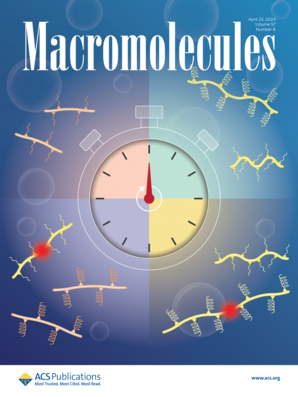Dynamic Cross-Linking Chemistry Enables Advanced One-Component Thermosets
IF 5.1
1区 化学
Q1 POLYMER SCIENCE
引用次数: 0
Abstract
This work discloses a new strategy based on dynamic cross-linking chemistry to achieve advanced one-component thermosets combining ultralong storage life and fast cross-linking. One-component thermosets containing resin and cross-linker in one pot have the features of simple operation, stable quality, and low waste; however, an urgently needed one with long storage life at room temperature and fast cross-linking at medium–low temperatures (≤130 °C) remains an enormous challenge. Herein, we innovatively propose a strategy of dynamic cross-linking and controlled dissolution to address this issue. As an example, a dynamic cross-linked cross-linker (DCC) is synthesized via Diels–Alder reaction to hide the high activity of a commercial amine-type cross-linker. A one-component thermoset from a DCC and a commercial diepoxy monomer can be stored for an ultralong time at room temperature and cross-linked rapidly below 130 °C. Moreover, the DCC can also serve as a latent accelerator for epoxy/anhydride thermosets with the same storage life as the control system with no accelerator at room temperature and fast cross-linking at elevated temperatures. This work is beneficial for promoting the application of dynamic cross-linking chemistry and meeting the urgent need for advanced one-component thermosets in the fields of advanced composites, coatings, electronic packaging materials, automotive and electronic adhesives, etc.

动态交联化学实现了先进的单组分热固性塑料
这项研究揭示了一种基于动态交联化学的新策略,以实现超长储存期和快速交联相结合的先进单组分热固性塑料。含有树脂和交联剂的单组分热固性塑料具有操作简单、质量稳定、浪费少等特点,但如何在室温下实现长贮存寿命,并在中低温(≤130 °C)下实现快速交联仍是一个巨大的挑战。在此,我们创新性地提出了一种动态交联和控制溶解的策略来解决这一问题。举例来说,我们通过 Diels-Alder 反应合成了一种动态交联交联剂 (DCC),从而掩盖了商用胺类交联剂的高活性。由 DCC 和商用二环氧单体制成的单组分热固性材料可在室温下存放超长时间,并在 130 °C 以下快速交联。此外,DCC 还可作为环氧/酸酐热固性塑料的潜在促进剂,其储存寿命与室温下不使用促进剂的控制系统相同,并可在高温下快速交联。这项工作有利于促进动态交联化学的应用,满足先进复合材料、涂料、电子包装材料、汽车和电子粘合剂等领域对先进单组分热固性材料的迫切需求。
本文章由计算机程序翻译,如有差异,请以英文原文为准。
求助全文
约1分钟内获得全文
求助全文
来源期刊

Macromolecules
工程技术-高分子科学
CiteScore
9.30
自引率
16.40%
发文量
942
审稿时长
2 months
期刊介绍:
Macromolecules publishes original, fundamental, and impactful research on all aspects of polymer science. Topics of interest include synthesis (e.g., controlled polymerizations, polymerization catalysis, post polymerization modification, new monomer structures and polymer architectures, and polymerization mechanisms/kinetics analysis); phase behavior, thermodynamics, dynamic, and ordering/disordering phenomena (e.g., self-assembly, gelation, crystallization, solution/melt/solid-state characteristics); structure and properties (e.g., mechanical and rheological properties, surface/interfacial characteristics, electronic and transport properties); new state of the art characterization (e.g., spectroscopy, scattering, microscopy, rheology), simulation (e.g., Monte Carlo, molecular dynamics, multi-scale/coarse-grained modeling), and theoretical methods. Renewable/sustainable polymers, polymer networks, responsive polymers, electro-, magneto- and opto-active macromolecules, inorganic polymers, charge-transporting polymers (ion-containing, semiconducting, and conducting), nanostructured polymers, and polymer composites are also of interest. Typical papers published in Macromolecules showcase important and innovative concepts, experimental methods/observations, and theoretical/computational approaches that demonstrate a fundamental advance in the understanding of polymers.
文献相关原料
公司名称
产品信息
阿拉丁
tetraethylenepentamine
 求助内容:
求助内容: 应助结果提醒方式:
应助结果提醒方式:


